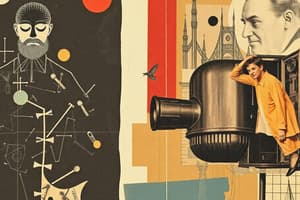Podcast
Questions and Answers
What is culture according to the definition?
What is culture according to the definition?
- The nature of reality and the nature of truth
- Patterned ways of thinking, feeling, and reacting acquired and transmitted mainly by symbols (correct)
- The shared assumptions that define what is real and what is not
- Acquired knowledge that people use to interpret experience and generate social behavior
According to Theory X, workers have a high level of ambition.
According to Theory X, workers have a high level of ambition.
False (B)
What are the three levels of culture, according to Schein's model?
What are the three levels of culture, according to Schein's model?
Underlying assumptions, espoused values, and artifacts
Culture is acquired knowledge that people use to interpret experience and generate social behavior, which includes ____________ values and creates ____________.
Culture is acquired knowledge that people use to interpret experience and generate social behavior, which includes ____________ values and creates ____________.
According to Theory Y, people view work as being a burden.
According to Theory Y, people view work as being a burden.
What is the main difference between sequential time cultures and synchronic time cultures?
What is the main difference between sequential time cultures and synchronic time cultures?
What is the significance of the time dimension in Schein's model?
What is the significance of the time dimension in Schein's model?
Match the following theories with their descriptions:
Match the following theories with their descriptions:
In Schein's model, underlying assumptions are related to the ________________________ of reality and the nature of truth.
In Schein's model, underlying assumptions are related to the ________________________ of reality and the nature of truth.
Schein's model consists of only two levels of culture.
Schein's model consists of only two levels of culture.
Flashcards are hidden until you start studying
Study Notes
Culture Definition
- Culture consists of patterned ways of thinking, feeling, and reacting acquired and transmitted mainly by symbols.
- It is the acquired knowledge that people use to interpret experience and generate social behavior.
- Culture forms values, creates attitudes, and influences behavior.
Schein's Model: Levels of Culture
- No specific details provided in the text.
Underlying Assumptions in Schein's Model
- The nature of reality and the nature of truth: shared assumptions that define what is real and what is not.
- The time dimension:
- How important is time?
- Do members of a culture live more in relation to the past, present, or future?
- Are they oriented more to the long-term or short-term?
- Examples: past-oriented, present-oriented, near future-oriented, and distant future-oriented.
- Sequential time cultures vs synchronic time cultures.
- Other underlying assumptions:
- The effect of spatial proximity and distance on behavior, interactions, and business practices.
Theory X and Theory Y - McGregor
Theory X
- Workers do not like to work and will avoid it whenever possible.
- Workers have little ambition, try to avoid responsibility, and like to be directed.
- Use of coercion, control, and threats of punishment is necessary.
- Most people are self-centered and must be closely controlled and often forced to achieve organizational objectives.
- Most people resist change.
- Most people are not particularly intelligent.
Theory Y
- People view work as being as natural as play and rest.
- People learn to accept and seek responsibility.
- People will be self-directed and creative to meet their work and organizational objectives if they are committed to them.
- People will be committed to their quality and productivity objectives if rewards are in place that address higher needs such as self-fulfillment.
Studying That Suits You
Use AI to generate personalized quizzes and flashcards to suit your learning preferences.




